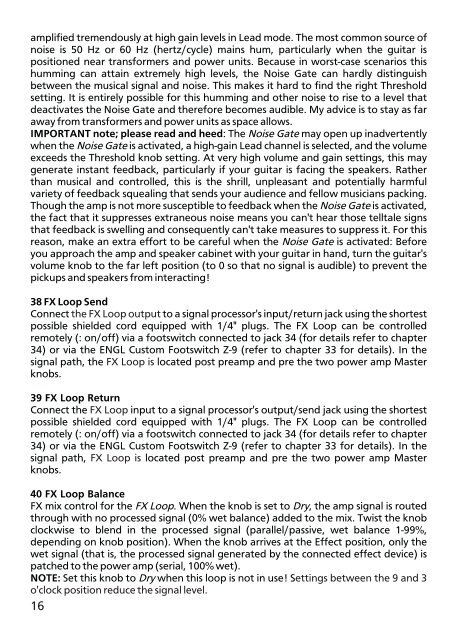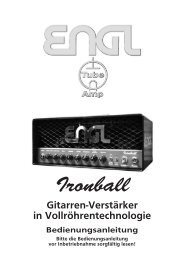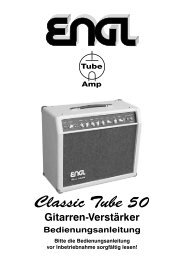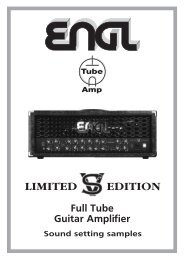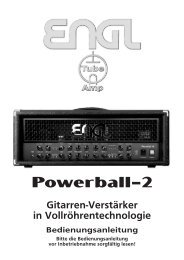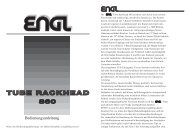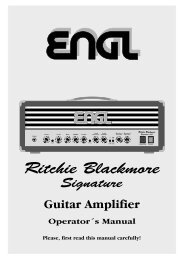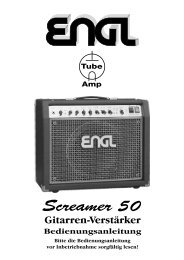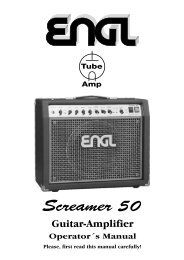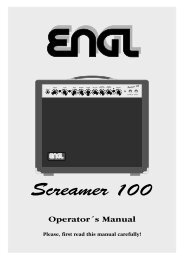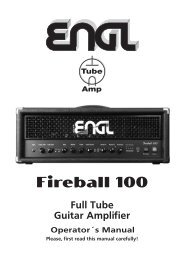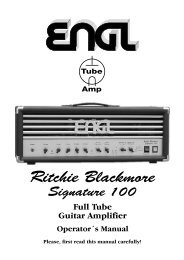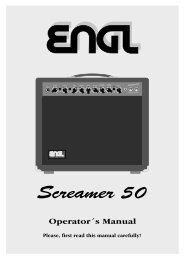LIMITED EDITION - Engl
LIMITED EDITION - Engl
LIMITED EDITION - Engl
Create successful ePaper yourself
Turn your PDF publications into a flip-book with our unique Google optimized e-Paper software.
amplified tremendously at high gain levels in Lead mode. The most common source of<br />
noise is 50 Hz or 60 Hz (hertz/cycle) mains hum, particularly when the guitar is<br />
positioned near transformers and power units. Because in worst-case scenarios this<br />
humming can attain extremely high levels, the Noise Gate can hardly distinguish<br />
between the musical signal and noise. This makes it hard to find the right Threshold<br />
setting. It is entirely possible for this humming and other noise to rise to a level that<br />
deactivates the Noise Gate and therefore becomes audible. My advice is to stay as far<br />
away from transformers and power units as space allows.<br />
IMPORTANT note; please read and heed:<br />
The Noise Gate may open up inadvertently<br />
when the Noise Gate is activated, a high-gain Lead channel is selected, and the volume<br />
exceeds the Threshold knob setting. At very high volume and gain settings, this may<br />
generate instant feedback, particularly if your guitar is facing the speakers. Rather<br />
than musical and controlled, this is the shrill, unpleasant and potentially harmful<br />
variety of feedback squealing that sends your audience and fellow musicians packing.<br />
Though the amp is not more susceptible to feedback when the Noise Gate is activated,<br />
the fact that it suppresses extraneous noise means you can't hear those telltale signs<br />
that feedback is swelling and consequently can't take measures to suppress it. For this<br />
reason, make an extra effort to be careful when the Noise Gate is activated: Before<br />
you approach the amp and speaker cabinet with your guitar in hand, turn the guitar's<br />
volume knob to the far left position (to 0 so that no signal is audible) to prevent the<br />
pickups and speakers from interacting!<br />
38 FX Loop Send<br />
Connect the FX Loop output to a signal processor's input/return jack using the shortest<br />
possible shielded cord equipped with 1/4" plugs. The FX Loop can be controlled<br />
remotely (: on/off) via a footswitch connected to jack 34 (for details refer to chapter<br />
34) or via the ENGL Custom Footswitch Z-9 (refer to chapter 33 for details). In the<br />
signal path, the FX Loop is located post preamp and pre the two power amp Master<br />
knobs.<br />
39 FX Loop Return<br />
Connect the FX Loop input to a signal processor's output/send jack using the shortest<br />
possible shielded cord equipped with 1/4" plugs. The FX Loop can be controlled<br />
remotely (: on/off) via a footswitch connected to jack 34 (for details refer to chapter<br />
34) or via the ENGL Custom Footswitch Z-9 (refer to chapter 33 for details). In the<br />
signal path, FX Loop is located post preamp and pre the two power amp Master<br />
knobs.<br />
40 FX Loop Balance<br />
FX mix control for the FX Loop. When the knob is set to Dry,<br />
the amp signal is routed<br />
through with no processed signal (0% wet balance) added to the mix. Twist the knob<br />
clockwise to blend in the processed signal (parallel/passive, wet balance 1-99%,<br />
depending on knob position). When the knob arrives at the Effect position, only the<br />
wet signal (that is, the processed signal generated by the connected effect device) is<br />
patched to the power amp (serial, 100% wet).<br />
NOTE: Set this knob to Dry when this loop is not in use! Settings<br />
between the 9 and 3<br />
o'clock position reduce the signal level.<br />
16


